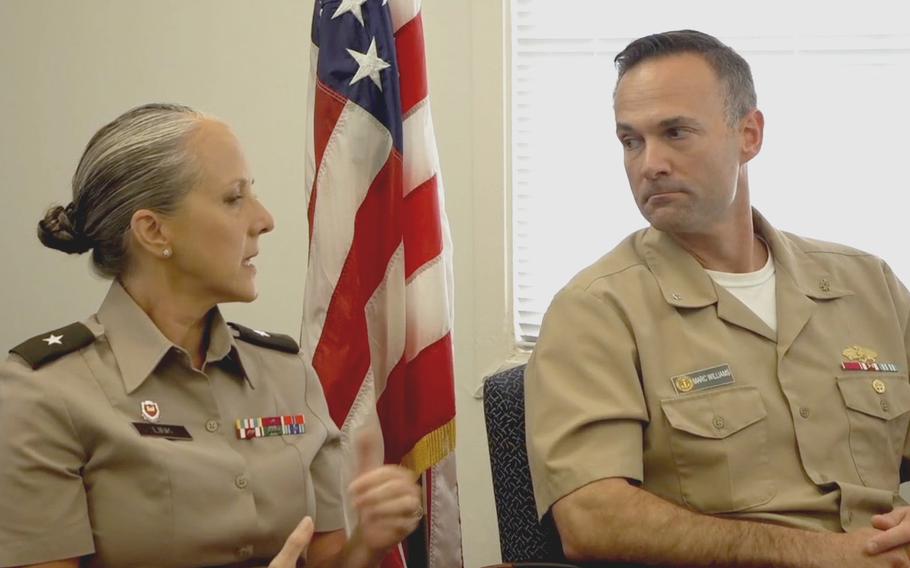
Rear Adm. Marc Williams, deputy commander of Navy Closure Task Force-Red Hill, and Brig. Gen. Michelle Link, deputy commander of Joint Task Force-Red Hill, update the closing of Red Hill Bulk Fuel Storage Facility in Hawaii in this screenshot from a Facebook Live briefing on Jan. 17, 2024. (Facebook)
FORT SHAFTER, Hawaii — Final cleansing of the 20 massive tanks that make up the Red Hill underground fuel storage facility in Hawaii will take three to four years, the deputy commander of the Navy task force in charge of the work said Wednesday.
The projected end to remediating the soil and aquifer contaminated by the facility, however, remains open-ended, Rear Adm. Marc Williams said during a Facebook Live presentation.
Williams, the chief engineer for the Navy Closure Task Force, was joined by Brig. Gen. Michelle Link, his counterpart on Joint Task Force-Red Hill, which has been overseeing the emptying of roughly 104 million gallons of fuel from the facility.
That task force will be phased out over the next few months, with the Navy task force this spring assuming sole responsibility for the lengthy process of closure and remediation.
Defense Secretary Lloyd Austin in March 2022 ordered the World War II-era facility closed in the wake of a jet fuel spill in late 2021 that contaminated the Navy’s water distribution system that served roughly 93,000 people.
The recently stood-up Navy Closure Task Force has reached initial operating capability, with about 80 of the 200 personnel who will join its ranks by the end of March, Williams said.
The next three to four years will be spent in part disassembling pipelines to empty residual fuel that could not be removed by any other means other than demolishing pipes.
The most time-consuming jobs, however, will be removing sludge from the bottoms of the 20 tanks and then cleaning the interior steel linings in the tanks, Williams said.
The entrance to each tank is about 190 feet above the bottom, he said. Tanks will be opened, ventilated and made safe for humans to enter, he said.
“Workers will be lowered down,” he said. “The sludge will be collected in a very manual way. Essentially, think of buckets and shovels and it will be taken up, out.”
The sludge will be “containerized” and then shipped to the mainland to be disposed of at facilities approved by the U.S. Environmental Protection Agency, he said.
The sludge will be handled with the highest level of oversight and scrutiny given to hazardous waste, even though the sludge is not categorized as hazardous, he said.
The “current concept of operations” for final cleaning of the interior of the tanks calls for using water from the Red Hill well shaft, which was contaminated by the November 2021 jet fuel spill.
Water has been continuously pumped out of that well since early 2022 as a means of preventing petroleum contamination from migrating into the aquifer from that site.
That water will be used to pressure wash the linings of the tanks, which each stand about 250 feet tall and 100 feet wide.
Williams equated the interior area to be cleaned in each tank as the surface area of 30 tennis courts.
Workers will be lowered in “buggies” to pressure wash from top to bottom, he said. The water will be collected, “appropriately treated,” and then “disposed,” he said.
A timeline for remediating the site will become clearer as the task force undertakes a site assessment to determine the best way forward, he said.